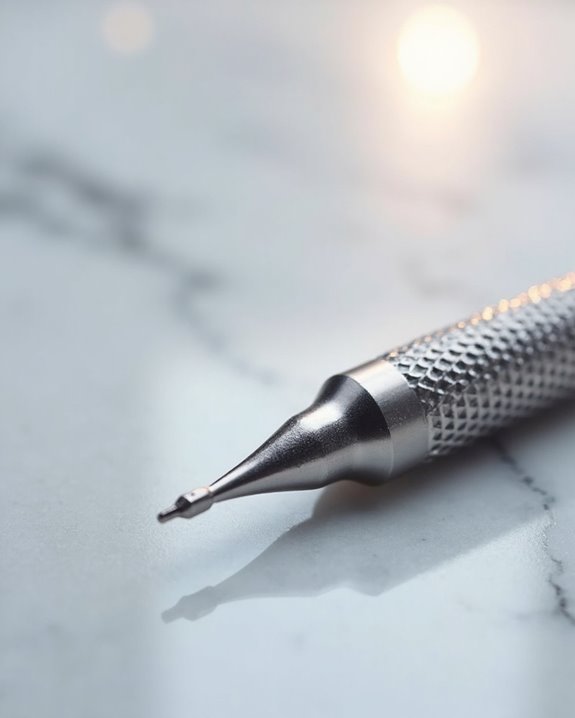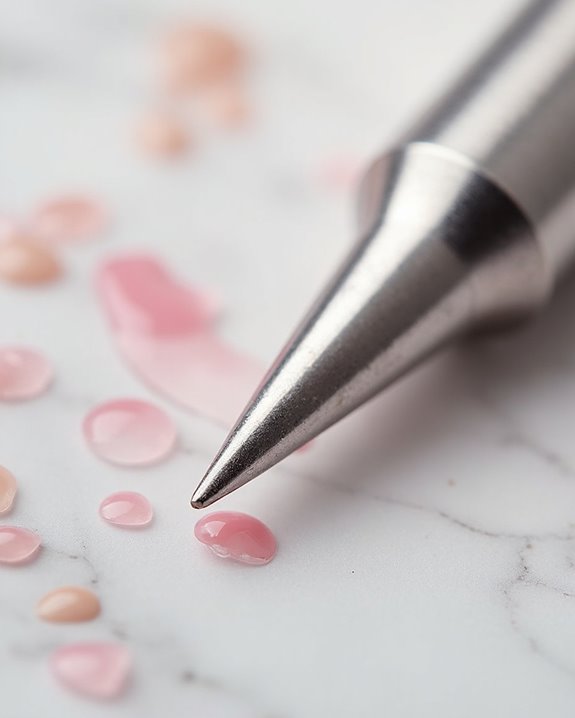The most effective cuticle drill bits include fine diamond ball bits for gentle exfoliation, Russian flame bits for accessing tight corners, and tungsten carbide bits for stubborn tissue removal. Ball-shaped bits excel at sensitive cuticle work when operated at medium speeds (around 60,000 RPM), while cone-shaped bits reach difficult sidewall areas. Safety bits with rounded tops provide protection for beginners. Proper selection depends on cuticle condition, with finer grits offering safer tissue removal while minimizing heat damage during treatments.
Key Takeaways
- Ball bits with fine grit provide gentle exfoliation for sensitive cuticles while minimizing damage to nail beds.
- Russian Flame bits effectively open cuticle pockets and remove sidewall debris when used at appropriate speeds.
- Diamond bits in ball or needle shapes offer precise control for cleaning cuticles without harming natural nails.
- Safety bits with rounded tops are ideal for beginners, reducing injury risk while accessing sidewalls and cuticles.
- Fine carbide bits efficiently remove stubborn dead cuticle tissue when operated at low-medium speeds around 60,000 RPM.
Which Nail Drill Bits Are Best for Cuticles?
When selecting nail drill bits for cuticle work, professionals and enthusiasts should prioritize both effectiveness and safety to achieve best results. The most efficient options include ball bits, which excel at exfoliating sensitive cuticle areas while promoting healthy nail beds, as demonstrated in fine grit versions like the Natural Nail Dry Mani Kit’s Refine Ball Bit.
Flame bits, particularly Russian Flame bits in fine grit, are specifically designed to open the cuticle pocket and remove debris from sidewalls. Diamond bits in ball and needle shapes effectively clean the cuticle area without damaging natural nails, while carbide bits like the Flame Coarse safely remove dead cuticle tissue at speeds up to 60,000 rpm. For beginners and professionals concerned with safety, rounded-top safety bits provide secure access to clean cuticles and sidewalls with minimal risk of injury.
Additionally, cone-shaped bits excel at reaching tight corners along sidewalls for comprehensive cuticle maintenance.
Understanding Cuticle Anatomy and Care Requirements
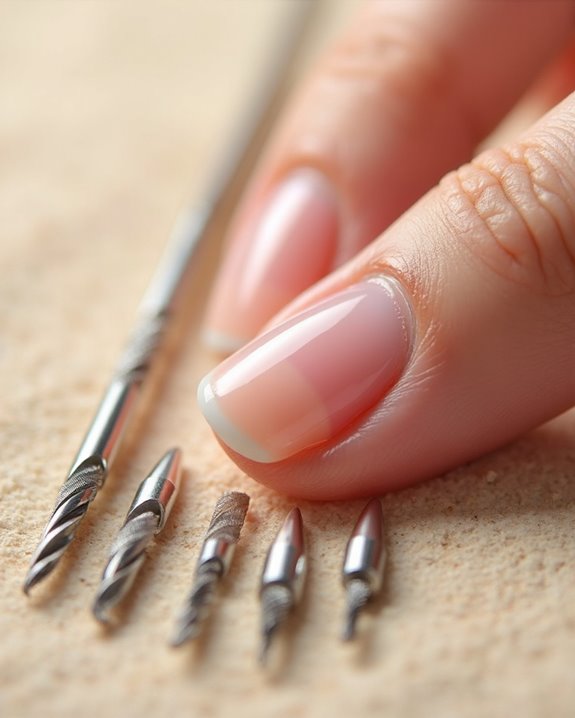
The proper understanding of cuticle anatomy serves as the foundation for effective nail care, particularly when utilizing electric files and specialized bits for maintenance. The cuticle, composed of the eponychium and proximal nail fold, provides essential protection for the nail matrix against infections and external damage. When approaching cuticle care, technicians must recognize that over-removal of dead cuticle can compromise this natural barrier, potentially affecting the nail bed’s health.
For this delicate work, ball head bits rated as fine or very fine offer precise control when cleaning the cuticle area, allowing for removal of dead skin around the nail without damaging the nail itself. Operating at medium speeds (approximately 60,000 RPM) with ball bits minimizes heat generation while effectively addressing the skin around the nail. Additionally, using tungsten carbide bits with extra-fine grit can further ensure safe and precise cuticle removal for home users.
Top Nail Drill Bit Shapes for Precise Cuticle Work

Selecting the appropriate nail drill bit shape stands as a critical factor in achieving professional-quality cuticle work, with each design offering specific advantages for different aspects of cuticle maintenance. Ball bits, particularly fine grit options like the Refine Ball Bit, excel at cuticle exfoliation and cleaning hard skin in sensitive areas. Safety bits, with their rounded tops, provide precise access to sidewalls and cuticle areas, making them ideal for beginners and in-fill procedures.
Cone bits feature a tapered shape that allows targeted precision when preparing the cuticle area without damaging the nail plate. Diamond ball and flame bits, including the Russian Flame in fine grit, enable technicians to open the cuticle pocket effectively, removing debris with accuracy. For detailed cuticle cleaning, carbide ball bits in specific sizes like 1.8mm deliver efficient results for both manicures and pedicures. Additionally, tungsten carbide bits are favored by professionals for their superior durability and heat dissipation in delicate cuticle tasks.
Diamond vs. Carbide: Material Comparison for Cuticle Maintenance
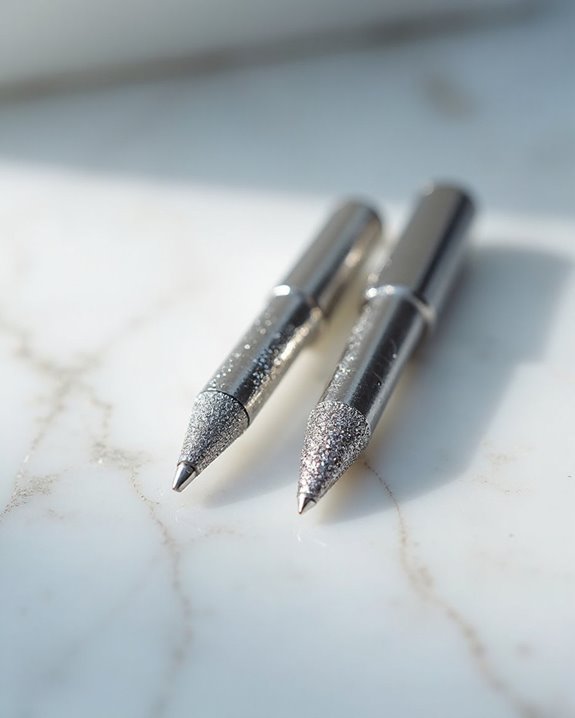
As nail technicians advance in their craft, understanding the fundamental differences between diamond and carbide bits becomes essential for delivering best cuticle maintenance results. Diamond bits, featuring fine and very fine grits, offer gentler exfoliation for natural nails while generating less heat during operation, making them ideal for thin cuticles and precise work around sidewalls. Their ball and needle shapes provide targeted control when cleaning the cuticle area.
Carbide bits, constructed from durable metal materials, excel at removing stubborn cuticles and skin buildup at speeds up to 60,000 rpm on low-medium settings. While the flame bit aggressively tackles dead skin and gel polish residue, these bits require careful monitoring to prevent overheating during prolonged use. Despite this limitation, carbide options maintain effectiveness for 150-300 services with proper maintenance.
Safety Features to Look for in Cuticle Drill Bits
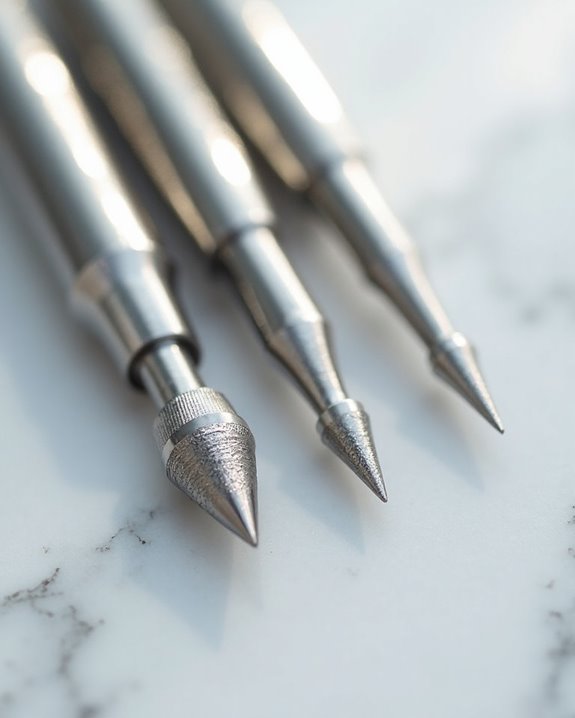
When choosing nail drill bits for cuticle work, safety features must take precedence, especially for those new to mechanical nail care. High-quality bits with Smooth Top designs offer essential protection, allowing technicians to navigate the cuticle area without damaging the natural nail or sidewalls. Consumers should select bits made from fine diamond grits or ceramic bits, which provide gentle yet effective tissue removal while minimizing heat buildup.
Safety-conscious users should prioritize bits specifically labeled as “safety bits,” featuring rounded tops and low to medium RPM capabilities (around 60,000 RPM). These quality bits, available in a variety of materials including rubber or metal, help avoid lifting of the natural nail and reduce skin irritation risks. For beginners, bits designed for thin skin and sensitive cuticles offer the most protection during routine maintenance.
Professional Techniques for Effective Cuticle Bit Use
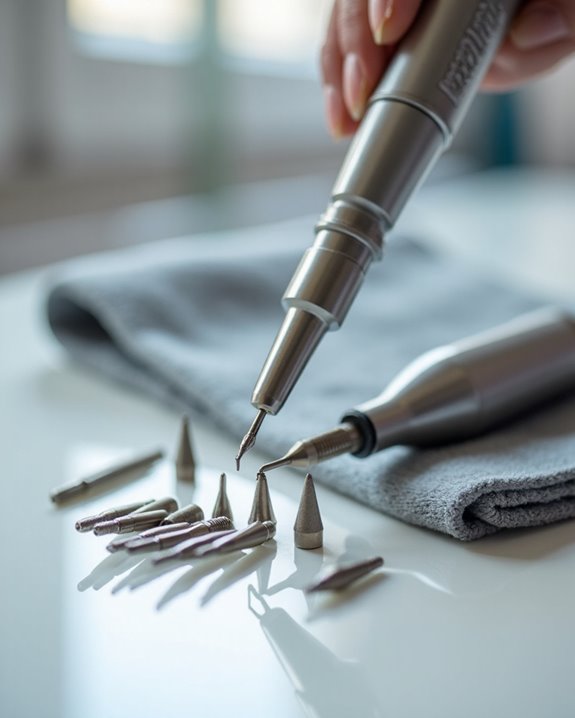
Professional nail technicians know that mastering cuticle bit techniques requires both proper tool selection and refined handling methods. When addressing the cuticle area and sidewalls, experts recommend operating a professional nail drill at approximately 60,000 RPM, maintaining this medium speed to prevent tissue damage while ensuring effective exfoliation. The UNC bit and flame carbide options excel at precise cuticle work, while cone bit and barrel bits provide versatile solutions for side walls and broader cleaning.
For ideal control during cuticle cleaner application, technicians stabilize their operating hand on a solid surface, preventing unexpected movements that could damage nail beds. After completing treatments, immediate bit cleaning with a brush, soap, and disinfectant prevents buildup that would compromise future procedures. This maintenance protocol extends bit lifespan through hundreds of services while maintaining hygienic standards.
Frequently Asked Questions
What Nail Drill Bit to Use for Cuticles?
For cuticle maintenance, professionals recommend fine grit ball, flame, or safety bits with rounded tops. Speed control and gentle pressure techniques are essential. Diamond and carbide bits offer durability while prioritizing proper hygiene practices between uses.
Can You Use a Nail Drill on Cuticles?
As delicate as butterfly wings, cuticles can be treated with nail drills when proper technique prevents skin damage. Usage warnings emphasize cuticle safety, minimizing drill risks through specialized bits, appropriate speed, and proper hygiene to avoid pain effects.
What Is a Bit That Can Be Used at the Cuticle?
For cuticle work, ball, flame, and safety bits offer varying durability and price points. Professional advice suggests beginners use safety bits, while maintaining all accessories properly extends their lifespan. Online tutorials demonstrate proper home usage techniques.
What Is the Difference Between Diamond and Carbide Nail Drill Bits?
What makes each nail bit unique? Diamond bits offer superior precision but less durability, while carbide bits provide toughness and grinding efficiency at higher speeds. Diamond generates less heat output but requires more maintenance. Cost difference reflects material properties.


